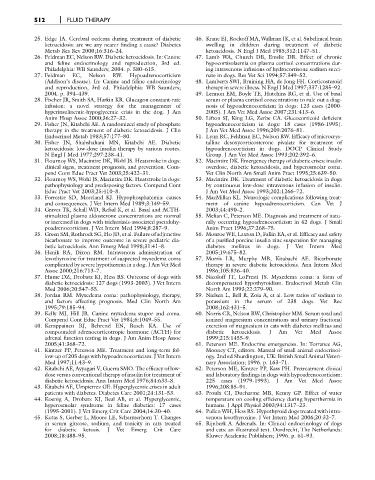Page 524 - Fluid, Electrolyte, and Acid-Base Disorders in Small Animal Practice
P. 524
512 FLUID THERAPY
25. Edge JA. Cerebral oedema during treatment of diabetic 46. Krane EJ, Rockoff MA, Wallman JK, et al. Subclinical brain
ketoacidosis: are we any nearer finding a cause? Diabetes swelling in children during treatment of diabetic
Metab Res Rev 2000;16:316–24. ketoacidosis. N Engl J Med 1985;312:1147–51.
26. Feldman EC, Nelson RW. Diabetic ketoacidosis. In: Canine 47. Lamb WA, Church DB, Emslie DR. Effect of chronic
and feline endocrinology and reproduction, 3rd ed. hypocortisolaemia on plasma cortisol concentrations dur-
Philadelphia: WB Saunders; 2004. p. 580–615. ing intravenous infusions of hydrocortisone sodium succi-
27. Feldman EC, Nelson RW. Hypoadrenocorticism nate in dogs. Res Vet Sci 1994;57:349–52.
(Addison’s disease). In: Canine and feline endocrinology 48. Lamberts SWJ, Bruining HA, de Jong FH. Corticosteroid
and reproduction, 3rd ed. Philadelphia: WB Saunders; therapy in severe illness. N Engl J Med 1997;337:1285–92.
2004. p. 394–439. 49. Lennon EM, Boyle TE, Hutchins RG, et al. Use of basal
28. Fischer JR, Smith SA, Harkin KR. Glucagon constant-rate serum or plasma cortisol concentrations to rule out a diag-
infusion: a novel strategy for the management of nosis of hypoadrenocorticism in dogs: 123 cases (2000-
hyperinsulinemic-hypoglycemic crisis in the dog. J Am 2005). J Am Vet Med Assoc 2007;231:413–6.
Anim Hosp Assoc 2000;36:27–32. 50. Lifton SJ, King LG, Zerbe CA. Glucocorticoid deficient
29. Fisher JN, Kitabchi AE. A randomized study of phosphate hypoadrenocorticism in dogs: 18 cases (1986-1995).
therapy in the treatment of diabetic ketoacidosis. J Clin J Am Vet Med Assoc 1996;209:2076–81.
Endocrinol Metab 1983;57:177–80. 51. Lynn RC, Feldman EC, Nelson RW. Efficacy of microcrys-
30. Fisher JN, Shahshahani MN, Kitabchi AE. Diabetic talline desoxycorticosterone pivalate for treatment of
ketoacidosis: low-dose insulin therapy by various routes. hypoadrenocorticism in dogs. DOCP Clinical Study
N Engl J Med 1977;297:238–41. Group. J Am Vet Med Assoc 1993;202:392–6.
31. Flournoy WS, Macintire DK, Wohl JS. Heatstroke in dogs: 52. Macintire DK. Emergency therapy of diabetic crises: insulin
clinical signs, treatment prognosis, and prevention. Com- overdose, diabetic ketoacidosis, and hyperosmolar coma.
pend Cont Educ Pract Vet 2003;25:422–31. Vet Clin North Am Small Anim Pract 1995;25:639–50.
32. Flournoy WS, Wohl JS, Macintire DK. Heatstroke in dogs: 53. Macintire DK. Treatment of diabetic ketoacidosis in dogs
pathophysiology and predisposing factors. Compend Cont by continuous low-dose intravenous infusion of insulin.
Educ Pract Vet 2003;25:410–8. J Am Vet Med Assoc 1993;202:1266–72.
33. Forrester SD, Moreland KJ. Hypophosphatemia: causes 54. MacMillan KL. Neurologic complications following treat-
and consequences. J Vet Intern Med 1989;3:149–59. ment of canine hypoadrenocorticism. Can Vet J
34. Graves TK, Schall WD, Refsal K, et al. Basal and ACTH- 2003;44:490–2.
stimulated plasma aldosterone concentrations are normal 55. Melian C, Peterson ME. Diagnosis and treatment of natu-
or increased in dogs with trichuriasis-associated pseudohy- rally occurring hypoadrenocorticism in 42 dogs. J Small
poadrenocorticism. J Vet Intern Med 1994;8:287–9. Anim Pract 1996;37:268–75.
35. Green SM, Rothrock SG, Ho JD, et al. Failure of adjunctive 56. Monroe WE, Laxton D, Fallin EA, et al. Efficacy and safety
bicarbonate to improve outcome in severe pediatric dia- of a purified porcine insulin zinc suspension for managing
betic ketoacidosis. Ann Emerg Med 1998;31:41–8. diabetes mellitus in dogs. J Vet Intern Med
36. Henik RA, Dixon RM. Intravenous administration of 2005;19:675–82.
levothyroxine for treatment of suspected myxedema coma 57. Morris LR, Murphy MB, Kitabachi AE. Bicarbonate
complicated by severe hypothermia in a dog. J Am Vet Med therapy in severe diabetic ketoacidosis. Ann Intern Med
Assoc 2000;216:713–7. 1986;105:836–40.
37. Hume DZ, Drobatz KJ, Hess RS. Outcome of dogs with 58. Nicoloff JT, LoPresti JS. Myxedema coma: a form of
diabetic ketoacidosis: 127 dogs (1993-2003). J Vet Intern decompensated hypothyroidism. Endocrinol Metab Clin
Med 2006;20:547–55. North Am 1993;22:279–90.
38. Jordan RM. Myxedema coma: pathophysiology, therapy, 59. Nielsen L, Bell R, Zoia A, et al. Low ratios of sodium to
and factors affecting prognosis. Med Clin North Am potassium in the serum of 238 dogs. Vet Rec
1995;79:185–94. 2008;162:431–5.
39. Kelly MJ, Hill JR. Canine myxedema stupor and coma. 60. Norris CR, Nelson RW, Christopher MM. Serum total and
Compend Cont Educ Pract Vet 1984;6:1049–55. ionized magnesium concentrations and urinary fractional
40. Kemppainen RJ, Behrend EN, Busch KA. Use of excretion of magnesium in cats with diabetes mellitus and
compounded adrenocorticotropic hormone (ACTH) for diabetic ketoacidosis. J Am Vet Med Assoc
adrenal function testing in dogs. J Am Anim Hosp Assoc 1999;215:1455–9.
2005;41:368–72. 61. Peterson ME. Endocrine emergencies. In: Torrance AG,
41. Kintzer PP, Peterson ME. Treatment and long-term fol- Mooney CT, editors. Manual of small animal endocrinol-
low-up of 205 dogs with hypoadrenocorticism. J Vet Intern ogy. 2nd ed Shurdington, UK: British Small Animal Veteri-
Med 1997;11:43–9. nary Association; 1996. p. 163–71.
42. Kitabchi AE, Ayyagari V, Guerra SMO. The efficacy of low- 62. Peterson ME, Kintzer PP, Kass PH. Pretreatment clinical
dose versus conventional therapy of insulin for treatment of and laboratory findings in dogs with hypoadrenocorticism:
diabetic ketoacidosis. Ann Intern Med 1976;84:633–8. 225 cases (1979-1993). J Am Vet Med Assoc
43. Kitabchi AE, Umpierrez GE. Hyperglycemic crises in adult 1996;208:85–91.
patients with diabetes. Diabetes Care 2001;24:131–53. 63. Proulx CI, Ducharme MB, Kenny GP. Effect of water
44. Koenig A, Drobatz KJ, Beal AB, et al. Hyperglycemic, temperature on cooling efficiency during hyperthermia in
hyperosmolar syndrome in feline diabetics: 17 cases humans. J Appl Physiol 2003;94:1317–23.
(1995-2001). J Vet Emerg Crit Care 2004;14:30–40. 64. Pullen WH, Hess RS. Hypothyroid dogs treated with intra-
45. Kotas S, Gerber L, Moore LE, Schermerhorn T. Changes venous levothyroxine. J Vet Intern Med 2006;20:32–7.
in serum glucose, sodium, and tonicity in cats treated 65. Rijnberk A. Adrenals. In: Clinical endocrinology of dogs
for diabetic ketosis. J Vet Emerg Crit Care and cats: an illustrated text. Dordrecht, The Netherlands:
2008;18:488–95. Kluwer Academic Publishers; 1996. p. 61–93.

